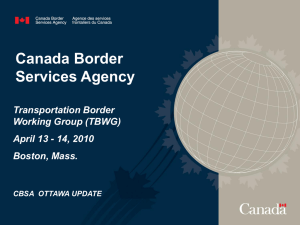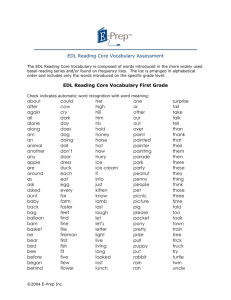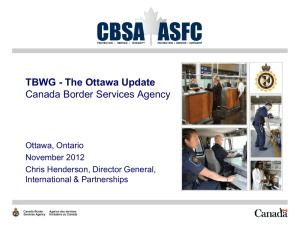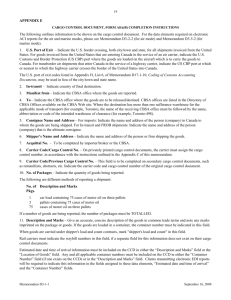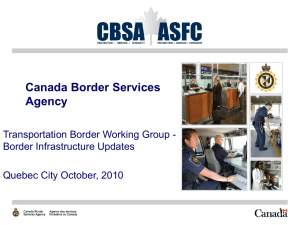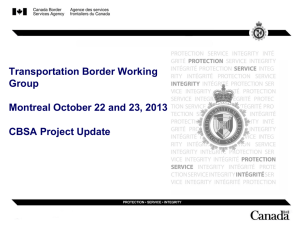Smart & Secure Borders - Kathy Carroll, CBSA
advertisement
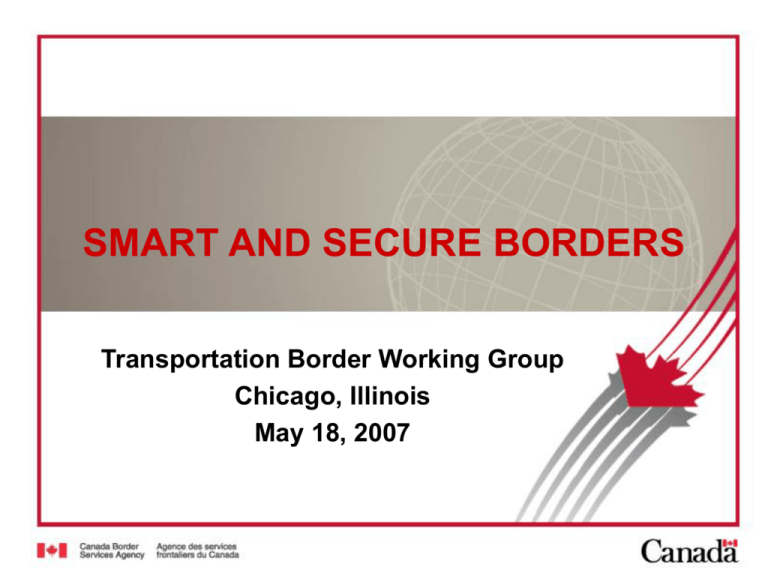
SMART AND SECURE BORDERS Transportation Border Working Group Chicago, Illinois May 18, 2007 OVERVIEW E-Manifest/Compatible Risk Targeting and Inspection Regimes C-TPAT/Partners in Protection (PIP) Business Resumption Planning WHTI / Driver’s Licence Pilot 2 On January 12, 2007 the Honourable Stockwell Day announced an investment of $431.6M over five years to reinforce smart, secure borders: $396M investment for eManifest $24M to further harmonize and strengthen business resumption planning with the USA $11.6M to further enhance the Partners in Protection (PIP) program 3 eMANIFEST – CONTEXT Security and Prosperity Partnership of North America “Identify, develop, promote and implement harmonized commercial processes, with initial focus on truck carried cargo manifests” United States Canada Mexico Canada Border Services Agency Securing our borders while facilitating trade and travel Advance Commercial Information Customs Self Assessment PHASE I Electronic pre-arrival receipt and risk assessment of commercial data from marine carriers for imported goods from overseas PHASE II Electronic pre-arrival receipt and risk assessment of commercial data from air carriers importing goods and marine carriers importing from the U.S. PHASE III eManifest - Electronic pre-arrival receipt and risk assessment of commercial data from highway and rail carriers, freight forwarders, importers and brokers 4 ADVANCE COMMERCIAL INFORMATION – PRE-ARRIVAL TRANSMISSION REQUIREMENTS Risk-based, automated targeting against electronic carrier and cargo information transmitted before goods arrive in Canada, in order to detect high-risk shipments containing contraband or posing a threat to health, safety, and/or national security. Part of Canada-U.S.- Mexico commitment towards collective security and economic prosperity. PHASE I April 2004: mandatory electronic, pre-arrival receipt and risk assessment of cargo and conveyance information from marine carriers for goods imported from offshore and transported by marine vessels PHASE II June 2006: mandatory electronic, pre-arrival receipt and risk assessment of cargo and conveyance information from air carriers and trans-border marine carriers PHASE III - eManifest Highway and rail conveyance information; Highway and rail cargo information; Freight forwarder secondary cargo information in all modes; Crew information in all modes; Importer admissibility information in all modes 5 eMANIFEST – LINK TO ADVANCE COMMERCIAL INFORMATION Carriers will provide electronic cargo and conveyance / crew information as follows: Freight forwarders will provide electronic secondary / supplementary cargo information as follows: Importers will provide electronic admissibility information as follows: Marine Air Rail Highway 24 hours prior to loading 4 hours prior to arrival or at departure 2 hours prior to arrival 1 hour prior to arrival 24 hours prior to loading 4 hours prior to arrival or at departure 2 hours prior to arrival 1 hour prior to arrival 24 hours prior to arrival 4 hours prior to arrival or at departure 2 hours prior to arrival 1 hour prior to arrival CBSA will validate data, risk assess the shipment, and make admissibility and/ or examination recommendations prior to arrival of the shipment in Canada 6 eMANIFEST END STATE – HIGHWAY Before Border At Border After Border Carrier transmits cargo, conveyance and driver data to CBSA Freight Forwarder transmits secondary data (if required) to CBSA Importers / Brokers transmit admissibility data to CBSA CBSA will electronically validate and confirm receipt of data CBSA will conduct automated risk assessment of shipments for further review by CBSA officer CBSA will make an entry/examination recommendation - transmit to border At PIL barcode/ transponder is read and entry / examination recommendation is communicated At PIL if driver not registered, officer verifies identity and admissibility, and final entry / examination decision is made Warehouse examination (if required) CBSA conducts post release verifications CBSA conducts compliance monitoring Exam results and risk assessment data used for detecting trends and patterns and for monitoring program effectiveness 7 REPORTING IT eMANIFEST END STATE – INTERNET PORTAL IT Prerequisites Electronic Reporting Notification System Description: A user-friendly, secure, and widely accessible option for clients to connect with the CBSA. Clients will be able to submit electronic information to the CBSA, query and verify status of shipments. Benefits: RISK Supports trade community’s ability to report and track shipments. Automated Risk Assessment Establishes the foundation for Single Window & Account based PASSAGE processing. Internet Portal A mechanism for trade chain partners to communicate with CBSA before they arrive at the border. Passage Status: Completion Target Dates Freight Forwarder Highway DATA Data Warehouse Importer Rail Compliance Management and Reporting 06 2007 2008 2009 Marine / Air Crew 2010 2011 8 PASSAGE RISK REPORTING IT eMANIFEST END STATE – PASSAGE IT Prerequisites Electronic Reporting Notification System Automated Risk Assessment Internet Portal Description: An integrated system for officers working at the Primary Inspection Line (PIL) that will provide them with a streamlined, user-friendly interface for border processing that is compatible with transponder technology. Benefits: Integrates existing systems- improves processing times. Supports valuable capacity of displaying driver pictures (Picture in Booth) to confirm the identity of drivers participating in the Free and Secure Trade (FAST) Driver Registration Program. Supports interoperability by reducing the number of screens and passwords (single logon) thereby reducing sign in time and decreasing time at the PIL Interoperable with Transponders /Smart Card technologies. Passage Status: Completion Target Dates Integrated PIL DATA Data Warehouse Transponders Compliance Management and Reporting Front Counter/ Secondary 06 2007 2008 9 2009 2010 2011 eMANIFEST – PROPOSED DEPLOYMENT PLAN IT 2006 2007 2008 2009 2010 2011 IT Prerequisites Spring 2008 REPORTING Automated Risk Assessment PASSAGE Notification System RISK Electronic Reporting Fall 2009 Internet Portal Integrated PIL Passage Transponders Spring 2011 Front Counter/Secondary Data Warehouse DATA Data Warehouse Advanced Analytics Business Intelligence and Reporting 10 In Transit Freight Forwarder Highway Importer Rail Marine / Air Crew eMANIFEST – MANDATORY ELECTRONIC REPORTING 2006 2007 2008 2009 Freight Forwarder Winter 2009 Highway Carrier Winter 2009 Importer 2010 2011 Winter 2010 Fall 2010 Rail Carrier Marine/Air Carrier (Crew) Spring 2011 Legislation Regulations 11 Proposed coming into force date eMANIFEST – STAKEHOLDER PARTNERSHIP NETWORK (eSPN) Inaugural eSPN meeting held January 18, 2007, in Ottawa. Over 150 participants from over 20 trade associations, US CBP, Aduana Mexico, CBSA and OGDs. eSPN will provide CBSA and its stakeholders with a forum for dialogue, input and guidance regarding the design, development and implementation of eManifest. eSPN will focus on the “how” of design and implementation throughout the 5-year deployment schedule. 12 For further information on eManifest: Caron Wilson Director, Advance Commercial Information and eManifest Project Phone: 613-954-3625 Caron.Wilson@cbsa-asfc.gc.ca 13 ENHANCING PARTNERS IN PROTECTION What is Partners in Protection (PIP)? PIP is a Canada Border Services Agency (CBSA) program designed to increase supply chain security through government/industry partnership focused on: Increased awareness of customs compliance issues Information exchange to help detect and prevent criminal and terrorist activities Enhanced physical and infrastructure security of supply chain participants 14 ENHANCING PARTNERS IN PROTECTION Funding announced in the spring budget will allow PIP to implement significant enhancements including: Increased focus on security of the supply chain through implementation of minimum security standards Better support to member companies through increased on site verifications, training and information exchange Work towards future mutual recognition among compatible supply chain security programs 15 ENHANCING PARTNERS IN PROTECTION SPP 2.1.2 designed to: Make compatible U.S.-Canada requirements for participation in Customs-Trade Partnership Against Terrorism (C-TPAT) and PIP within 36 months (June 2008). Key points of the SPP commitment: Minimum security standards Joint training sessions with C-TPAT Joint security reviews with C-TPAT Secure additional resources Conduct regional reviews Improved program delivery 16 For further information on Partners in Protection: Stephen John A/Manager, Partners In Protection Phone: (613) 946-9174 Fax: Stephen.John@cbsa-asfc.gc.ca 17 BUSINESS RESUMPTION PLANNING Objective Develop coordinated business resumption protocols at the border in the event of disaster and/or increased alert levels. 18 BUSINESS RESUMPTION PLANNING Actions to date: Recent and significant work has focused on defining communication and coordination mechanisms. CBSA/CBP draft Business Resumption: Communication and Coordination Plan formalize the process for inter-agency communications and communications with industry. Plan provides guidance for CBP and CBSA during instances where precise, accurate and timely communication between the two organizations is crucial. The plan is supported by agency-specific operating instructions for implementation within each of CBSA and CBP. 19 BUSINESS RESUMPTION PLANNING April 12, 2007 tabletop exercise called Pacific Venture, focused on government to trade issues. 102 key industry and bi-national government representatives. International customs organizations from Australia, Mexico, New Zealand attended Pacific Venture as observers. The exercises demonstrated the concepts explored by the project team are valid. 20 BUSINESS RESUMPTION PLANNING Current Work: The CBSA/CBP project team met May 1, 2007, to finalize the First Impression Reports (FIR) for tabletop exercises. In the next few weeks, the working group will review, analyse, and prepare action items to address the identified gaps. 21 BUSINESS RESUMPTION PLANNING Next Steps: The Exercise After Action Reports for the tabletop exercises will be finalized in late June. The final Business Resumption Protocols and Communication and Coordination Plan will be disseminated to the Regions by the end of July 2007. Local-level work will then begin, related to communication linkages and related border access issues (traffic management, goods management – smart access). 22 For further information on Business Resumption Planning: Stuart MacPherson Director, Emergency Preparedness and Health & Safety Phone: 613-948-4447 Fax: 613-948-1273 Stuart.MacPherson@cbsa-asfc.gc.ca 23 ENHANCED DRIVER’S LICENSE (EDL) PILOT PROJECT Secure driver’s license, that denotes citizenship and identity as a cross-border travel option to meet WHTI requirements. Canadian Conceptual Design developed by federal /provincial working group in December 2006. Canada will work with BC, DHS and Washington State (and other provinces, territories and states) on development of their DL pilots. Washington State / British Columbia EDL pilots anticipate a January, 2008 implementation. 24 WASHINGTON STATE PILOT Legislation passed by Washington State (WS) supporting enhanced driver’s licenses for cross-border travel. MOU between Washington State and DHS signed March 23, 2007. DHS / Washington State EDL Business Plan to be completed by end of April 2007. Open to WS residents who are U.S. Citizens and wish to obtain a state issued document that denotes citizenship for the purpose of crossing the Canada / U.S. border. Applicant will appear at WS DL issuing office with documents that denote both identity and citizenship (i.e., passport, birth certificate, etc.). 25 WASHINGTON STATE PILOT DL officials will interview applicant to determine document validity, then scan and save these documents. DL officials use visual and technological checks to determine document authenticity / fraudulency. If DL officials cannot determine citizenship with confidence, applicant will be referred to the U.S. Department of State to obtain proper citizenship document in order to continue application process. DL card will contain a Machine Readable Zone (MRZ) and Radio Frequency Identification (RFID). 26 CANADIAN EDL PILOT OVERVIEW 300 to 500 Canadian citizens to participate Up to 6 months to run Pilot EDL(s) issued from a limited number of Provincial driver licensing offices which meet SPP 1.1.3 standards Citizenship validation undertaken by Provinces; if unable to determine citizenship, client will be required to obtain passport Card production and issuance occurs after citizenship is validated Card to meet secure standards, including a MRZ, and a vicinity RFID chip 27 CANADIAN EDL PILOT OVERVIEW Participant information sent to CBSA by secure channel. EDL card info to be shared with DHS/CBP for entry to U.S. CBSA will process EDL documents using current border processes, statistics can be collected for use in evaluation. 28 ENHANCED DRIVER’S LICENSE (EDL) PROVINICIAL PILOT PROJECT Application, Validation and Issuance of EDL - Provincial DL Authority Citizenship Validation Application Process Card Issuance/Status •Voluntary travel option •Additional fee for EDL •Foundation documents provided are visually inspected for legitimacy •Citizens born in pilot jurisdiction to be interviewed and foundation documents validated against provincial vital statistics •All other Canadians to have their citizenship validated through document review and in-depth interview •Where citizenship cannot be determined, applicant must obtain passport •SPP compliant card produced at card production facility •Issued and sent to applicant by secure mail •Radio Frequency Identification (RFID) •ICAO compliant MRZ •Participant information to be sent to CBSA and DHS using secure process Use of EDL at Port of Entry Canadian EDL Reference List* DHS CBSA •EDL can be presented at any Canadian border crossing •Periodic collection of existing CBSA passage records provides statistics related to enhanced DL document usage for evaluation Canadian EDL Reference List and Personal Information for RFID •RFID processing of documents •Collection, storage and use of pilot participant’s (both U.S. and Canadian) personal information •Collection of passage records and statistics related to enhanced DL document usage Note: *EDL reference list to include information associated to each individual, their document and possibly their vehicle •Documents presented with application to be scanned and retained by province (TBD) •GoC involvement will be kept to a minimum. •There will be no documentary requirements for entry to Canada •There will be no RFID processing of documents upon entry to Canada •Absence of a functional inter-jurisdictional information exchange (no NRS) to assist in validation of citizenship Process Flow 29 Process & Information Sharing ENHANCED DRIVER’S LICENSE (EDL) PILOT PROJECT Next Steps: Continue development of necessary policy, evaluation, privacy and legal frameworks Work with provinces to develop a Canadian EDL business model Secure any necessary funding Ensure Canadian business model has DHS support Work with provinces to develop implementation plans for pilots Evaluation 30 For further information on the Enhanced Drivers License Pilot: Andrew Lawrence A/Manager, Consultation Western Hemisphere Travel Initiative Tel: (613) 957-1604 E-mail: andrew.lawrence@cbsa-asfc.gc.ca 31 Presented By: Kathy Carroll Cabinet and Portfolio Affairs Canada Border Services Agency Phone: (613) 952-2369 Email: kathy.carroll@cbsa-asfc.gc.ca 32
